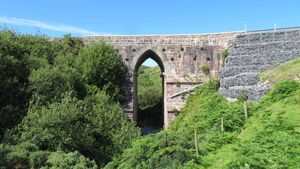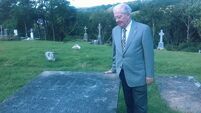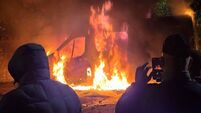A wonderful journey of discovery through Mayo

Glennanean Bridge, on the road to Achill from Mulranny, is one of the many attractive bridges designed and constructed by the renowned Scottish engineer Alexander Nimmo in 1829/30. It's one of many fascinating entries in John O'Callaghan's 'West Mayo Placenames'. Picture: John O'Callaghan
For those who love being of this county – and there are thousands whose passion for Mayo runs deep – the great thing is there are always more discoveries for you around the corner and sometimes right in front of you. Mayo is a gift that keeps on giving.
If you are someone who wants to delve deeper into our county, our towns and villages, our placenames, then John O’Callaghan’s is a must-read.
You will not fail to come away from reading without a much greater knowledge for this county. You will certainly come away with a greater appreciation of the beauty that lurks around so many corners. And you will be fascinated by all the new information you will glean from it.
This book, released late last year, focuses on townlands and placenames in the three western baronies of Mayo – Murrisk, Burrishoole and Erris, covering ground from the Galway border at Leenane all the way north to Rossport at the northern end of Erris.
It is not exhaustive – not every townland in the three baronies is included but those which are between the pages are wonderfully assessed and explored.
So much of our culture, history, geography, language and lore is rooted in our placenames. By just reading a detailed Ordinance Survey map, you can decipher so much about a region.
O’Callaghan goes much deeper. He writes about all of these townlands with such feeling and appreciation for them and with a real sense of guardianship. His respect for the importance of preserving not just the knowledge behind all of the placenames but, far more importantly, the natural resources throughout all these townlands, jumps off the page.
It draws on the magnificent work of the late Dr Fiachra Mac Gabhann whose magnum opus, , will forever remain an exceptional study of the county’s placenames. Indeed, O’Callaghan dedicates the book to Dr Mac Gabhann ‘and his magisterial work’. It is a term that can be applied to O’Callaghan’s work, too.
A townland is, as O’Callaghan sets out in his preface, ‘a sub-parochial geographical division, unique to Ireland and the Western Isles of Scotland’. There are more than 3,400 townlands in Mayo.
But within each townland there are rich divisions too with many fields having their own name, derived from its geography or history.
The late, great map-maker and writer Tim Robinson estimated there were approximately 14,000 little fields on the Aran Islands, containing an almost equal number of names.
As Professor Emeritus Patrick Duffy wrote in the book’s foreword, these local placenames ‘encapsulate the soul of the place – the sounds and dialects of ancestors’.
What further elevates this book is the author’s passion for hillwalking. He’s not writing this book from behind a desk, he is writing about places where he has hiked, traversed, breathed the air, admired the contours of the hills, the meanderings of streams and rivers, spoken to locals to try to strip back the potential meaning of potentially confusing placenames.
It becomes a guide for so many hidden gems in this county and when you put this book down, don’t be surprised if you draw up a list of those you want to visit. I certainly did.
It is a book that is a voyage of discovery in more ways than one!
O’Callaghan gives wise counsel in terms of safety, access and sustainable use of such gems.
You will be amazed what you discover about places you thought you knew. Every time I leave or return to Achill, I cross over a bridge some three kilometres west of Mulranny. I had no idea until I read how magnificent a structure it is because you can only see a fraction of it from the road. Glennanean Bridge was one of many attractive bridges designed and constructed by the renowned Scottish engineer Alexander Nimmo in 1829/30.
The book is full of marvelous details like this.
Quoting the late, great writer Michael Viney in his foreword, Professor Patrick Duffy noted how ‘a farmer with no Irish is a stranger in his own land’. As someone with an admittedly poor grasp of my native tongue, though with eternal intentions to change that, this hit home. The book served as an education of many placenames whose names I knew but origins I did not.
Erriff, An Oirimh, meaning ‘the arable’ or ‘arable land’. Annagh/Lannagh meaning a marsh brought echoes of the futility of Mayo GAA plans for a Centre of Excellence at the shores of Lough Lannagh in Castlebar! Bellacragher Bay (outside Mulranny) translates to ‘the mouth of the plunderer’, a most vivid name!
The book shows the richness and depth of the Irish language. Manchán Magan’s was well-named.
Of course, while this book reveals much the reader may not be aware of, John O’Callaghan is very precise in detailing what he does and does not know. There remains a mystery over so many placenames in this county.
As O’Callaghan writes about the townland of Cloonmonad in Westport (which forms a large part of what is simply known as the Quay nowadays), the original reason for the naming of a place can be so corrupted over the years with translations, knowledge being passed orally rather than in writing, accents etc.
O’Callaghan is extremely well-versed on the subject matter. One doubts there is a book on Mayo history, geography, people and places that he has failed to read, which is confirmed by reading his bibliography. He picks apart and analyses previous efforts in a very fair and respectful way. His passion for the subject matter is matched by his aptitude for it.
There is so much depth and breadth to this book. Learn about everything from the connection the English phrase ‘up to my oxters’ links with Mayo placenames to the link of a remote Erris townland with Harry Potter.
O’Callaghan’s book is very accessible. He explains complex geographical and geological themes very well and is extremely diligent in his conclusions for possible origins. He applies various levels of certainties and explains why.
It is produced in full colour throughout and is a quality production with scores of striking photographs of the townlands and various features therein.
What John O’Callaghan has done with this absolutely magnificent book is create a great understanding of so much of our county, preserve so much knowledge and highlight the importance to us all of uncovering the history of placenames in our own neck of the woods from older generations before such rich knowledge is lost.
It reminds me of Fr Seán Noone’s , which explored much of the history of townlands in Erris (the Kilcommon Civil Parish, which includes all of Erris east of the bridge to the Mullet peninsula) in the sense it will be a much sought after book for years and decades to come, and will be well thumbed by those who have a copy.
It is a book I cannot speak highly enough about. I couldn’t put it down.






